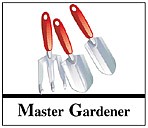May 23, 2003 at 10:27 a.m.
Speaking of weather, as I write this article the third rain in a week has just ended. The three rainfalls totaled almost six inches and while spring rains are food for apple trees; cold rain and wind can be damaging to apple blossoms. Fortunately, the blossoms were not fully developed at the time of the heavy rain.
In my last article I wrote about controlling plum curculios and the codling moth in the home orchard. The timing was important because spraying must begin when about three-fourths of the blossoms have fallen.
There is more time to control the apple maggot; in fact some gardeners make the mistake of spraying for the apple maggot at the same time as other insects. This pest makes brown lines throughout the inside of the apple and disfigures the apple from the outside. Apple maggots develop from eggs laid in the fruit by small black and white flies. The flies usually being to emerge from the soil in July and in approximately seven to ten days are ready to lay eggs. Many eggs may be laid in a single apple and are inserted under the skin of the fruit. Egg laying may continue throughout August and September. The eggs hatch into larvae or maggots that feed and tunnel in the flesh of the fruit. Their trails turn brown and heavily infested fruit breaks down or rots. The larvae live for three or four weeks and many times cause the infested apples to fall. The full-grown maggots then crawl out of the apple and burrow into the soil, ready to begin the cycle again next season.
Timing of spraying is important. Maggot traps will help determine when to spray but they will not deter the maggot fly. Commercial traps with attractant are available, but you can also make traps. Properly colored and coated, an old croquet ball equipped with a screw eye and hung by wire in a tree will work.
Hang one trap per tree by the first of July and examine them every day or two. Apply the first spray after a catch of two to five flies per trap. Since flies continue to emerge, additional sprays should be applied as long as you catch flies in the traps. Sprays should not be repeated more often then 10 to 14 days, and they should not be applied after the indicated pre-harvest interval for the particular chemicals.
Use a general orchard spray, which can be purchased at most garden centers, especially if you intend to control specific apple diseases. Sevin or Imidan is very effective but be sure you don't apply it within 30 days of full bloom, as it will cause thinning of the smaller apples. This may not be all bad if the tree is loaded.
There are several other products and combinations that can be used and are effective. If you go into a garden center in hopes of buying any chemical, be sure you talk with someone who knows what they are talking about.
Keep asking until you find someone who does.
One of the master gardeners told me about a mixture that she uses on her fruit trees. Use a plastic half gallon milk container and add one-fourth cup of sugar, one-fourth cup of apple vinegar, and one cup of water. I used the mixture last year for the first time and it collected a ton of bugs. Whether it would have replaced spraying, I doubt it. However, if you only have a couple of trees or if you haven't had insect problems in the past, it may be enough.
By the way, I hang the container with wire slanting toward the northeast as rain rarely comes from that direction during the summer.
For more information on the U of M Extension Service web page go to www.extension.umn.edu and search. Or, you may call our Yard and Garden Line anytime and leave a message at (612) 624-4771. A Master Gardener will return your call. The Master Gardeners also staff the Extension Office on Monday from 4:30 to 8 p.m. Call (651) 674-4417 or drop in with your samples and gardening questions.




Comments:
Commenting has been disabled for this item.